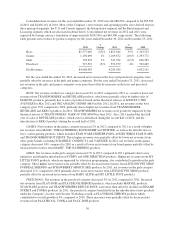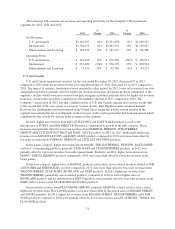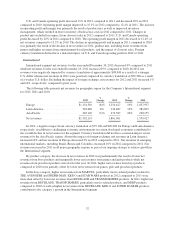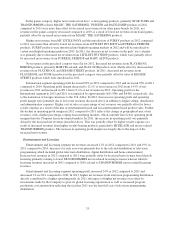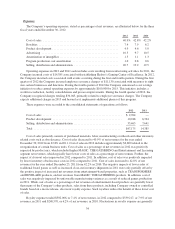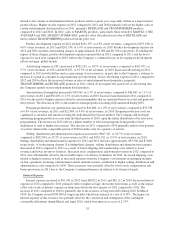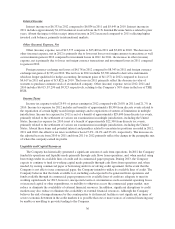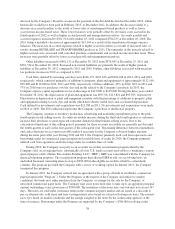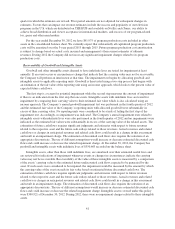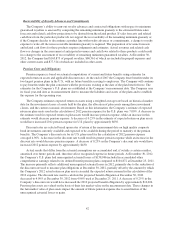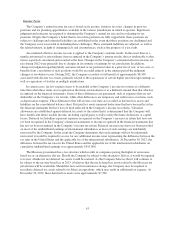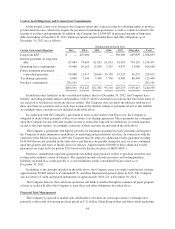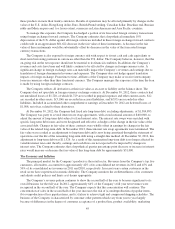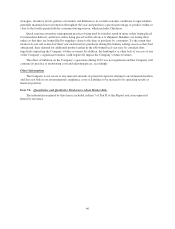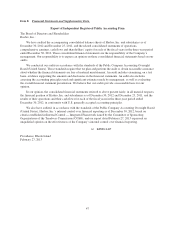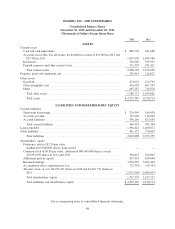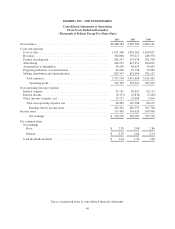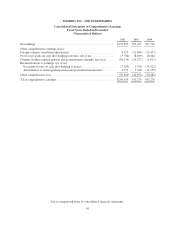Hasbro 2012 Annual Report Download - page 50
Download and view the complete annual report
Please find page 50 of the 2012 Hasbro annual report below. You can navigate through the pages in the report by either clicking on the pages listed below, or by using the keyword search tool below to find specific information within the annual report.
outstanding at December 30, 2012. Letters of credit and similar instruments include $174,870 of bonds related to
the defense of tax assessments in Mexico. These assessments relate to transfer pricing that the Company is
defending and expects to be successful in sustaining its position. In addition, the Company is committed to
guaranteed royalty and other contractual payments of approximately $98,888 in 2013.
Critical Accounting Policies and Significant Estimates
The Company prepares its consolidated financial statements in accordance with accounting principles
generally accepted in the United States of America. As such, management is required to make certain estimates,
judgments and assumptions that it believes are reasonable based on information available. These estimates and
assumptions affect the reported amounts of assets and liabilities at the date of the financial statements and the
reported amounts of revenues and expenses for the periods presented. The significant accounting policies which
management believes are the most critical to aid in fully understanding and evaluating the Company’s reported
financial results include sales allowances, program production costs, recoverability of goodwill and intangible
assets, recoverability of royalty advances and commitments, pension costs and obligations and income taxes.
Sales Allowances
Sales allowances for customer promotions, discounts and returns are recorded as a reduction of revenue
when the related revenue is recognized. Revenue from product sales is recognized upon passing of title to the
customer, generally at the time of shipment. Revenue from product sales, less related sales allowances along with
license fees and royalty revenue comprise net revenues in the consolidated statements of operations. The
Company routinely commits to promotional sales allowance programs with customers. These allowances
primarily relate to fixed programs, which the customer earns based on purchases of Company products during the
year. Discounts and allowances are recorded as a reduction of related revenue at the time of sale. While many of
the allowances are based on fixed amounts, certain of the allowances, such as the returns allowance, are based on
market data, historical trends and information from customers and are therefore subject to estimation.
For its allowance programs that are not fixed, such as returns, the Company estimates these amounts using a
combination of historical experience and current market conditions. These estimates are reviewed periodically
against actual results and any adjustments are recorded at that time as an increase or decrease to net revenues.
During 2012, there have been no material adjustments to the Company’s estimates made in prior years.
Program Production Costs
The Company incurs certain costs in connection with the production of television programs based primarily
on the Company’s toy and game brands, including animated and live-action programs and game shows. These
costs are capitalized as they are incurred and amortized using the individual-film-forecast method, whereby these
costs are amortized in the proportion that the current year’s revenues bear to management’s estimate of total
ultimate revenues as of the beginning of each fiscal year related to the program. These capitalized costs are
reported at the lower of cost, less accumulated amortization, or fair value, and reviewed for impairment when an
event or change in circumstances occurs that indicates that an impairment may exist. The fair value is determined
using a discounted cash flow model which is primarily based on management’s future revenue and cost
estimates.
The most significant estimates are those used in the determination of ultimate revenue in the individual-
film-forecast method. Ultimate revenue estimates impact the timing of program production cost amortization in
the consolidated statement of operations. Ultimate revenue includes revenue from all sources that are estimated
to be earned related to the television program and include toy, game and other merchandise licensing fees; first
run program distribution fees; and other revenue sources, such as DVD and digital distribution. Our ultimate
revenue estimates for each television program are developed based on our estimates of expected future results.
We review and revise these estimates at each reporting date to reflect the most current available information. If
estimates for a television program are revised, the difference between the program production cost amortization
determined using the revised estimate and any amounts previously expensed during that fiscal year, are included
as an adjustment to program production cost amortization in the consolidated statement of operations in the
40


